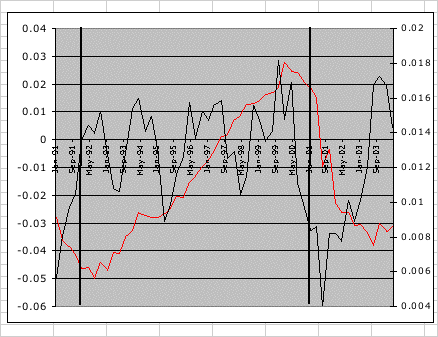From [Marc Abrams (2004.09.17.2305)]
[From Rick Marken (2004.09.17.1900)]
Since never. But this is a discussion group, and I think it's helpful
to discuss things.
Discuss what? How brilliant you are? Or maybe how insightful Powers is?
What a crock. Neither one of you is man enough to admit that you might have
made a mistake. Instead you come out and try to attack my credibility, when
_any_ first year calculus student would know and recognize my argument as
being the correct one.
But rather than try and come to some understanding, by using a text if
necessary, you blather;
Bill's definition of the derivative is correct, yours is nonsense. An...
What a fool you are. I took my equation right out of my _old_ calculus text
book. So I guess Powers not only knows more about behavior than any
psychologist, he also happens to know more economics than any living
economist and more of the Calculus than any mathematician.
What a true Renaissance man he is. I hope he actually gets back to the 21st
century some day.
Yet he readily admits;
"I'm a bit hazy about the details here; it's been some years since I
reviewed the facts. At any rate, it takes a certain amount of charge to
change"
And
"But I don't keep up with the literature, so maybe I'm just way behind
everyone else."
You put an awful lot of trust in someone Rick, who doesn't seem to care all
that much about his current level of knowledge, or his willingness to look
at new ideas or new advances when they happen.
I guess one day an over active student will discover exactly what Powers has
spent so much time trying to avoid and be able to solidify the concept of
control in human behavior.
Because Rick, as much as you and Bill want to deny it, Human behavior is a
_great_ deal more than a simple tracking task and the questions people have
about control are not about how a six legged caterpillar moves on the
ground, it's about how control affects the cognitive processes we use on a
daily basis for our own choices and choices that ultimately affect others.
You can pooh-pooh this all you want, but I recently realized why George
Richardson felt you (meaning Bill P)'went-into-the tank' with your tracking
task. George actually thinks the world of you and your work and he was very
disappointed that you did not go after the 'cognitive' or higher level stuff
rather than the mundane lower level stuff.
Your refusal to address the questions posed by Bruce Gregory and others and
more importantly your insistence on working from the neurons on up is an
absolute disaster.
Until PCT can begin to model an integrated set of processes that account for
our cognitive behavior, PCT will be a fringe, incomplete, view of human
behavior at best.
You don't make progress by sticking your head in the sand and making believe
other things don't exist.
One day you are going to find out that there is no status quo to protect
Marc
